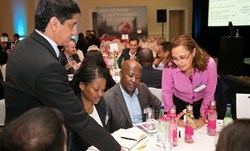Late last week saw the convergence of leaders in industries such as ICT, logistics, oil and gas, healthcare, etc. at the Table Bay Hotel, V&A, for the Growth, Innovation and Leadership Conference by Frost & Sullivan.
Attendees were treated with breakfast pastries and coffee, before being bombarded with ideas, theories and thoughts that truly were like drinking from a fire hose as Dorman Followwill suggested. Followwill was also the icebreaker of the day with his first keynote speech "Disrupt, collapse and transform" which set the tone and theme for the entire conference.

Dorman Followwill
The problems and the solutions - innovation is key
In a world where technology moves faster than companies can keep up, and good ideas are abundant, innovation is what will keep a company going. Followwill showed attendees what challenges businesses are facing by using the "disrupt, collapse and transform" model.
Disruption is when businesses are faced with serious and threatening competition from new and innovative technology and ideas. Collapse is when said innovative technology renders a business redundant. He proves this by using Kodak and Blockbuster brands that disappeared in the timespan of years or even months; it really is adapt or die.
There is however, light at the end of the tunnel: transformation. Investing in, and using new technologies to transform your business, partner with previously unexpected partners and integrate, integrate, integrate (which was another keyword of the day). This allows people to not only transform their businesses, but allows for solution-based innovative thinking, leading to comprehensive service delivery by integrating various new technologies, business models, industries and companies. This brings us to the next and probably most important point of the entire conference.
Go mobile and connect
In Followwill's next keynote speech he outlined some of the mega trends that are influencing industries, such as Big Data, the green movement, going smart, and health and wellbeing. Of all the mega trends, the most important seems to be connectivity; in fact, it's so important that it influences the other mega trends as they too are going mobile.
Being able to connect is essential in the modern world, whether it's connecting B2B, B2C, C2C, P2P, G2B (the possible connections are endless really), because it inevitably leads to the convergence of industries, products, technologies and competitors. The question is: 'How are these connections made?"
Here comes the ICT industry! The answer is, go mobile and become visible and approachable online.
More and more businesses are using applications on mobile phones and tablets to make their services easier to acquire. Whether you are trying to flag down a taxi or looking for just the right pair of pants, you can now do it all from your computer, phone or tablet.
Although most businesses have an online presence and mobile platform these days, they still need people on the ground. If you buy the perfect pair of pants, it won't just magically appear on your lap or get delivered to you by a drone as suggested at the conference (South-Africa is not quite there yet). This is where convergence comes in. A retailer uses ICT industry services to become an e-retailer, they then partner with the logistics industry to achieve service delivery, successfully converging three different industries or businesses. This is the stuff future business and services are made of.
Putting heads together
As if to prove a point, industry leaders were given the opportunity to converge right at their tables. Using the industries relevant at the table attendees were sitting at, as well as a business model template provided by Frost & Sullivan, heads of businesses and leaders of industries were able to brainstorm convergence opportunities in a solutions-based think tank.
Most businesses and companies looked at the problems facing them and how going mobile or online can solve these problems as well as how partnerships can benefit their companies. Some managed to create amazing new products and services all together. These included an app-based e-retailer for self-sustainable power producing roofs, microchip-regulated health and data generation, 3D online assisted glass fittings with 3D printing and online integrated service delivery with the option to rate. All of the groups used mobile function, online presence and interesting and unexpected partnerships to create, innovate and transform. It wouldn't be surprising if the next big product or applications gets born out of the GIL conference.
That's all good and well, but what about Africa?
In recent years, Africa has become a hub of investment opportunities. No-one can say it's easy to operate in such a volatile continent, but apparently the juice is worth the squeeze - especially with the surge in mobile traffic data.
According to The Guardian, there will be more than 635 million mobile subscribers in sub-Saharan Africa which will continue to increase in the next five to ten years as well as the use of internet data on mobile phones that will increase twenty-fold in the next five years. This surge can be contributed to poor infrastructure such as the lack of landlines as well as people like Alpesh Patel, Founder and CEO of Mi-Fone, Africa's own smartphone, inundating the African continent with quality technology.
This bodes well for Africa, as there are many things the continent needs that mobile technology can provide.
Practical applications
So what are some of the practical applications? Healthcare, availability of information and education, circumventing infrastructure problems, disaster relief, agriculture, etc. The possibilities are ubiquitous. There are two sectors where Africa stands the most to gain and investors seem most keen on investing in and that is healthcare and logistics. This is also where the ICT industry becomes facilitators for convergence, where devices and platforms meet services and products to provide Africa with what it needs.
We are talking about combining health oriented companies and organisations with technology to find practical solutions to dire health problems, like Amref Health Africa that provides mobile medical services to people in Africa as well as self-diagnostic tools that are available as apps on mobile phones. Likewise, the convergence of technology, logistics and local suppliers and producers may lead to practical solutions to the logistical challenges that currently face Africa. This may enable companies like DHL, one of the biggest international logistics companies which is already operational in Africa, to gain access to previously isolated groups and consumers, who in turn gain access to previously unavailable products and services.
How does GIL2014 help?
The conference created the perfect platform for industry leaders from companies such as Frost and Sullivan, DHL, Neotel, etc. to put their minds and skills together to discuss and find practical and innovative solutions for challenges that businesses face in an increasingly modern and technologised world.
For businesses and companies who already have a foot in Africa and the African market, the conference provided a much needed exchange of advice and learnings as well as an opportunity to celebrate that which they already achieved. Even more so, the conference gave many the opportunities to connect in a way that will perhaps lead to the ultimate and effective connectivity of Africa.



























